Table of Contents
- Introduction
- Editor’s Choice
- Global Digital Identity Solutions Market Overview
- Knowledge Regarding the Term “Digital Identity”
- People’s Definition of Digital Identity
- People’s Trust in Digital Identity Solutions
- Issues Driving the Demand for Digital Identity Solutions
- Identity Verification for AML/KYC Purposes
- Popular Digital Identity Schemes
- Technological Advancements in Digital Identity Solutions
- Regulatory Standards for Digital Identity Solutions
- Challenges in Implementing Digital Identity Solutions
Introduction
According to Digital Identity Solutions Statistics, Digital identity solutions are vital for confirming and overseeing identities in today’s digital landscape. They utilize technologies such as biometrics and cryptography to validate users securely. These solutions are pivotal in establishing trust and security in online transactions, spanning from online shopping to governmental activities.
Critical elements encompass methods for authentication, processes for verifying identities, and systems for managing identities. Emerging patterns consist of decentralized identity, biometric validation, the zero-trust security model, and endeavors to enhance interoperability.
In essence, digital identity solutions serve as the cornerstone of the digital economy, ensuring protected and smooth online interactions while preserving user confidentiality.
Editor’s Choice
- In 2022, the global digital identity solutions market stood at a total revenue of USD 28.0 billion, with solutions accounting for USD 17.0 billion and services for USD 11.0 billion.
- By 2032, the global digital identity solutions market is forecasted to exceed $131.6 billion, reflecting the increasing importance and adoption of digital identity technologies across various industries and sectors.
- The global digital identity solutions market is characterized by a dominant presence of biometric identity types, which command a substantial market share of 68%.
- Globally, only 58% of the respondents reported understanding the term ‘digital identity’ in a survey. However, this understanding varied significantly across countries.
- In terms of trust in delivering a single digital identity service, respondents across all countries indicated their bank as the most preferred choice, with 49% expressing confidence in this option.
- The primary culprit behind significant insider data breaches is human error, according to 84% of organizations reporting security incidents stemming from mistakes.
- The UN and World Bank’s ID4D initiative, in collaboration, aims to ensure that every individual worldwide possesses a legal identity by the year 2030.
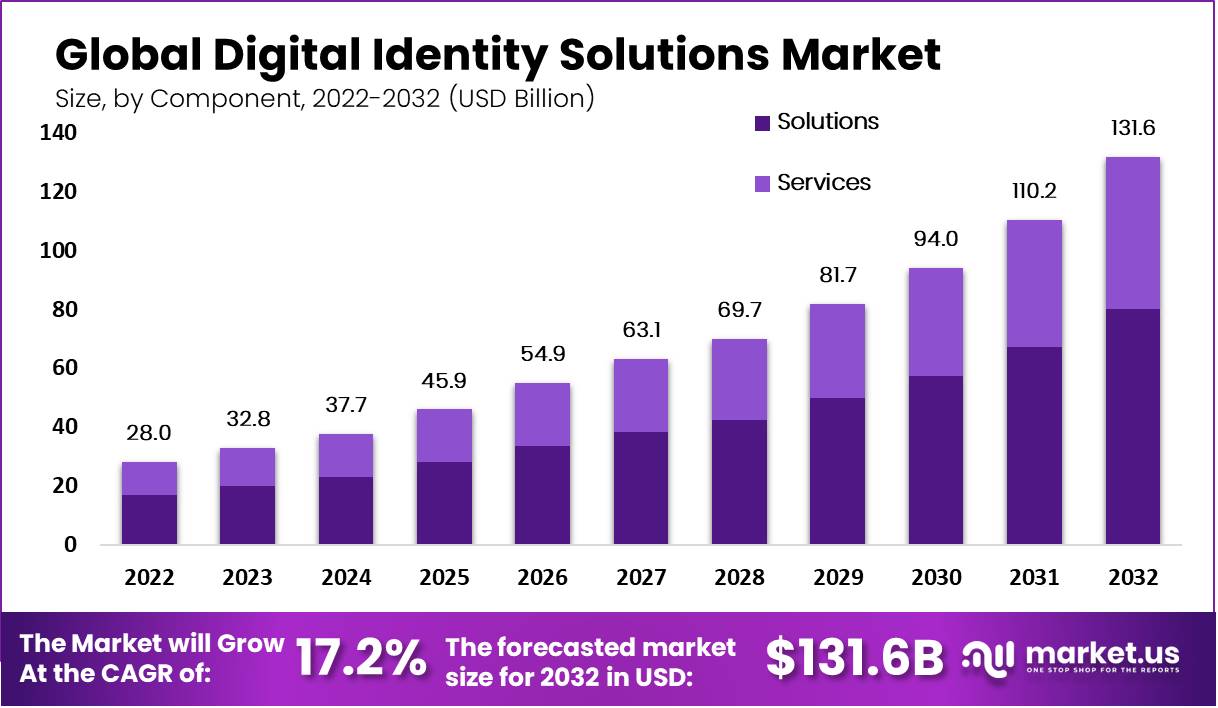
Global Digital Identity Solutions Market Overview
Global Digital Identity Solutions Market Size
- The global digital identity solutions market has experienced significant growth at a CAGR of 17.2 %, with revenues climbing steadily over the years.
- Starting at $28.0 billion in 2022, the market saw an increase to $32.8 billion in 2023, followed by a further rise to $37.7 billion in 2024.
- Looking ahead, the market is expected to continue its upward trajectory, with revenues projected to hit $94.0 billion in 2030 and reach $110.2 billion by 2031.
- By 2032, the global digital identity solutions market is forecasted to exceed $131.6 billion, reflecting the increasing importance and adoption of digital identity technologies across various industries and sectors.
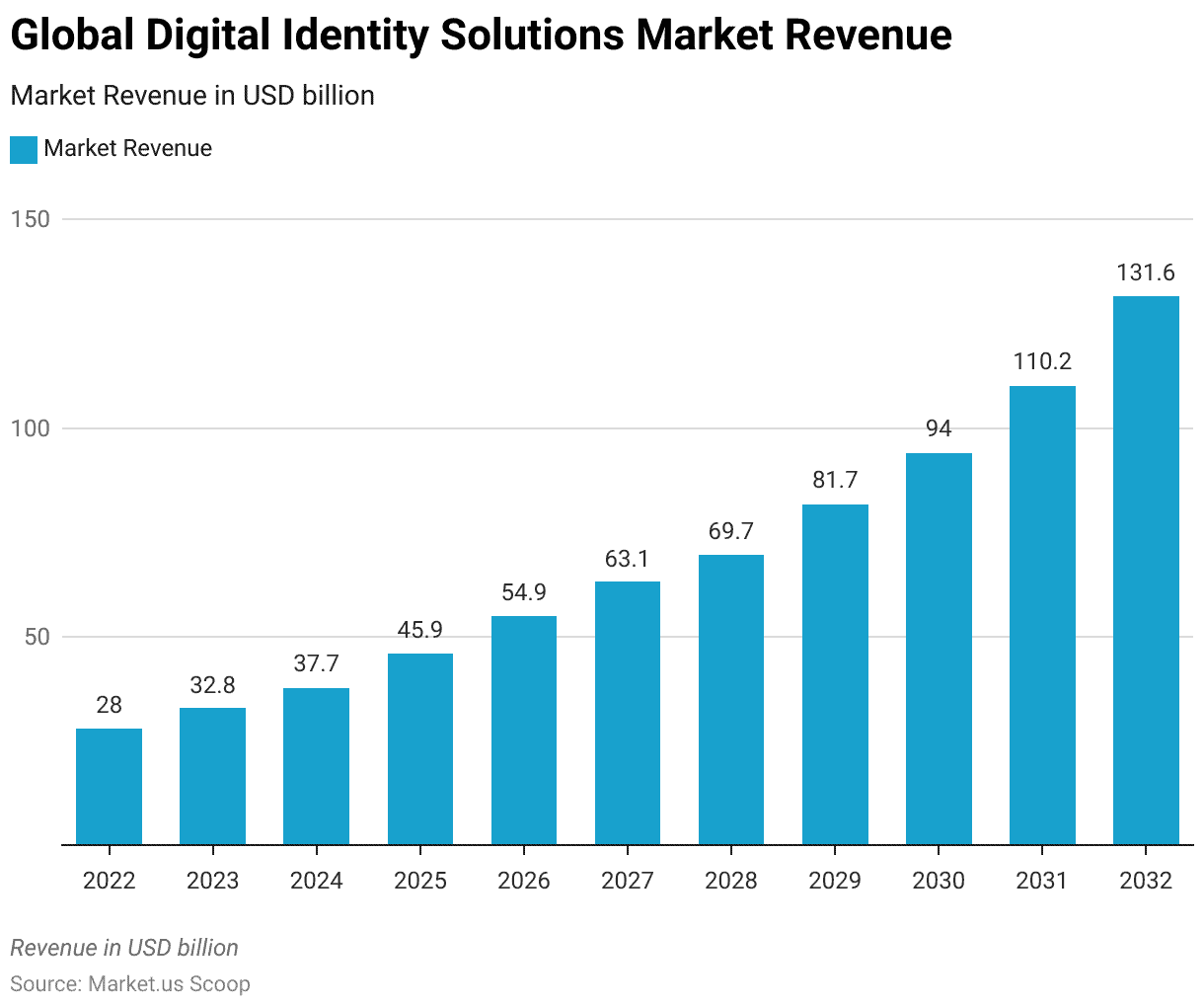
Digital Identity Solutions Market Size – By Component
- In 2022, the market stood at a total revenue of USD 28.0 billion, with solutions accounting for USD 17.0 billion and services for USD 11.0 billion.
- The market continued to expand, reaching USD 32.8 billion in 2023, with solutions generating USD 20.0 billion and services USD 12.9 billion.
- This growth trajectory persisted, with the market size climbing to USD 37.7 billion in 2024, comprising USD 22.9 billion from solutions and USD 14.8 billion from services.
- Over the subsequent years, the market is projected to witness exponential growth, with revenue reaching USD 131.6 billion by 2032.
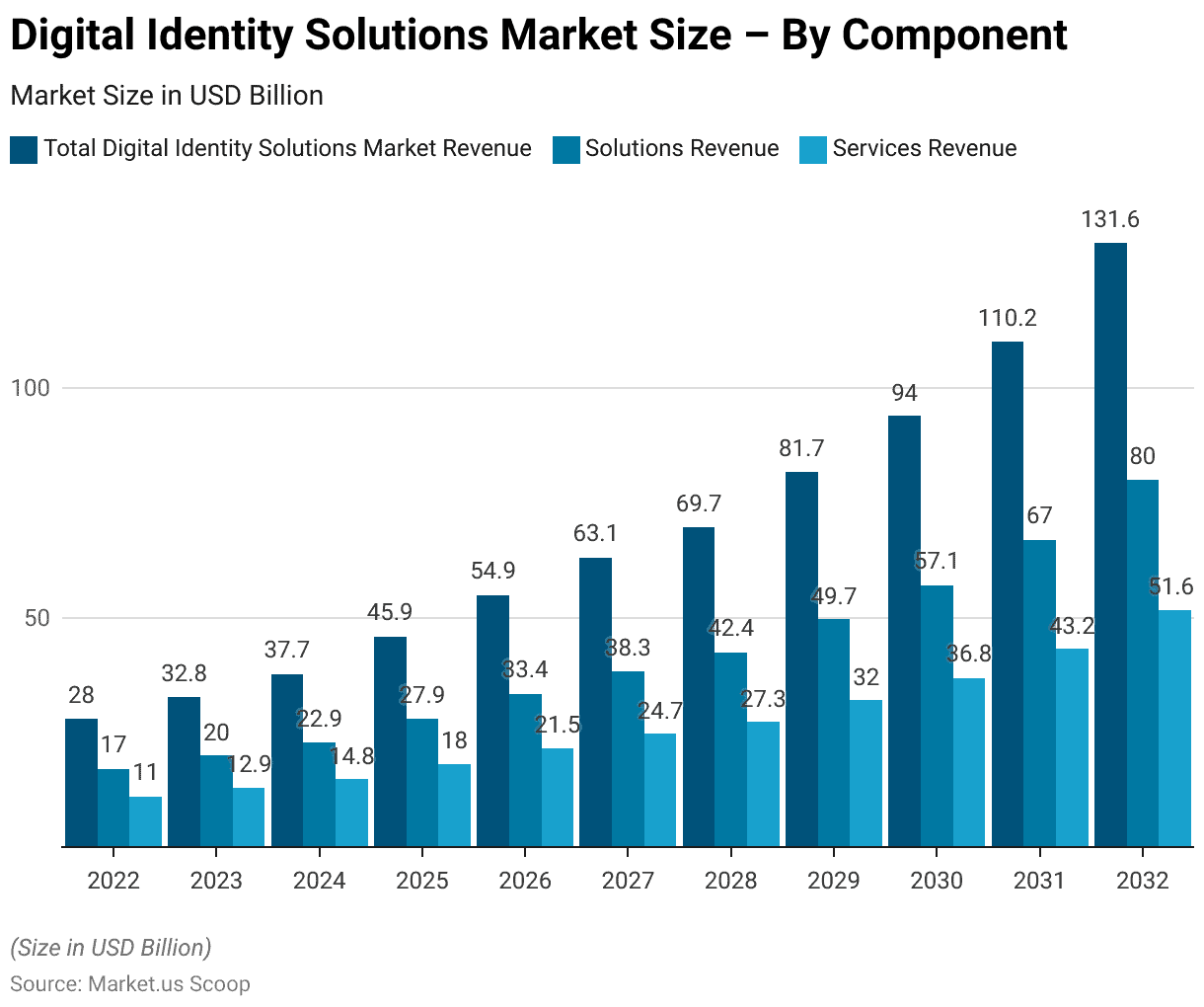
Global Digital Identity Solutions Market Share – By Identity Type
- The global digital identity solutions market is characterized by a dominant presence of biometric identity types, which command a substantial market share of 68%.
- While non-biometric methods encompass a range of identity verification techniques such as knowledge-based authentication and tokenization, they often serve as complementary approaches to biometric technologies or are preferred in scenarios where biometric data collection is impractical or less feasible.
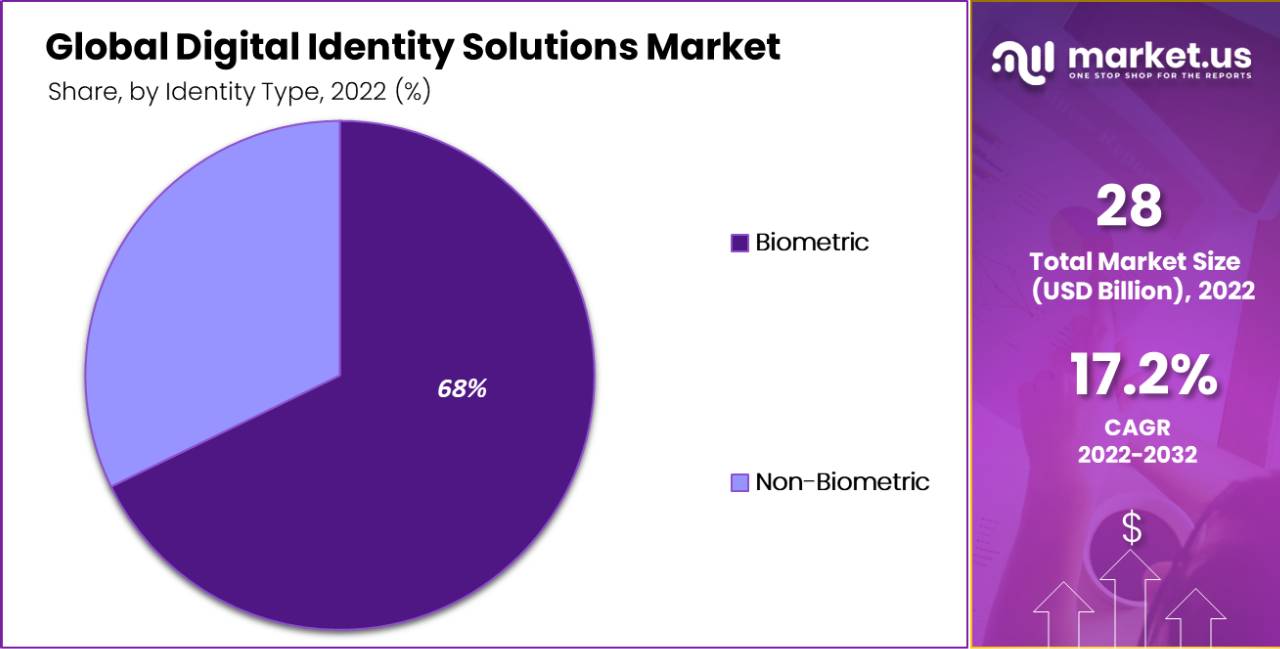
Knowledge Regarding the Term “Digital Identity”
- Globally, only 58% of the respondents reported understanding the term ‘digital identity’ in a survey. However, this understanding varied significantly across countries.
- For example, Italian participants demonstrated greater confidence, with 83% expressing familiarity with the concept.
- In contrast, respondents from the United States showed the least certainty in their comprehension of digital identity, with only 45% indicating that they understood the term.
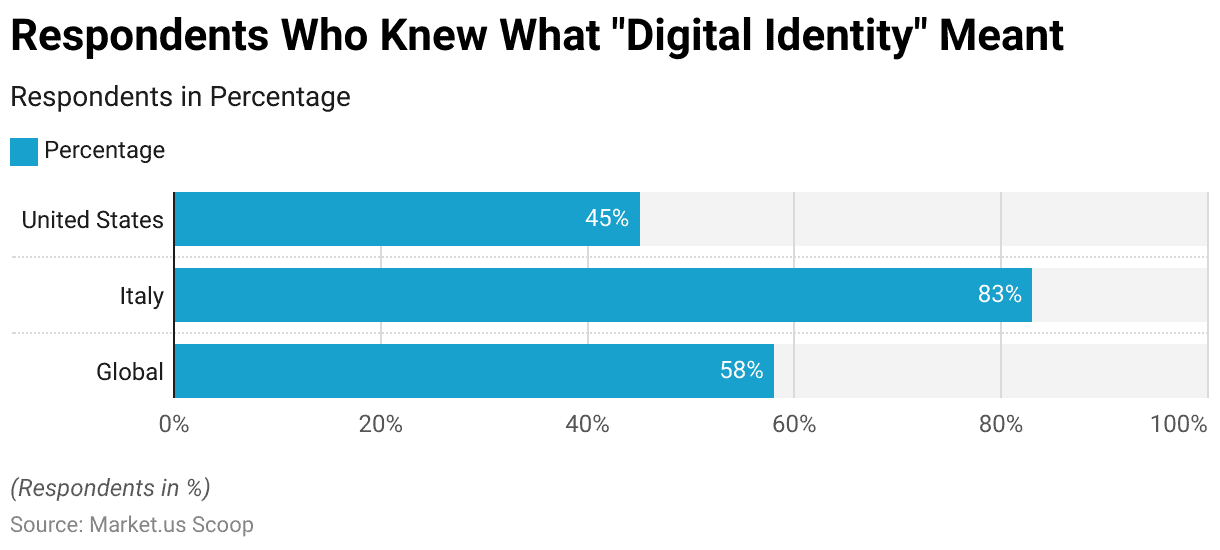
People’s Definition of Digital Identity
- Among the respondents, 42% identified ‘any information existing online about oneself’ as the definition of digital identity, which was deemed the most accurate option provided.
- Notably, German participants were the most likely to select this definition, with 52% agreeing.
- Alternatively, 14% of respondents viewed their digital signature or e-signature as their digital identity, while 5% associated it with their email address.
People’s Trust in Digital Identity Solutions
- In terms of trust in delivering a single digital identity service, respondents across all countries indicated their bank as the most preferred choice, with 49% expressing confidence in this option.
- Google garnered 26% of trust, ranking highest in Mexico but lowest in Germany.
- Conversely, government agencies were selected by 23% of respondents, with Australia reporting the highest trust level and Mexico and the United States showing the lowest levels of confidence in government entities for providing digital identity services.
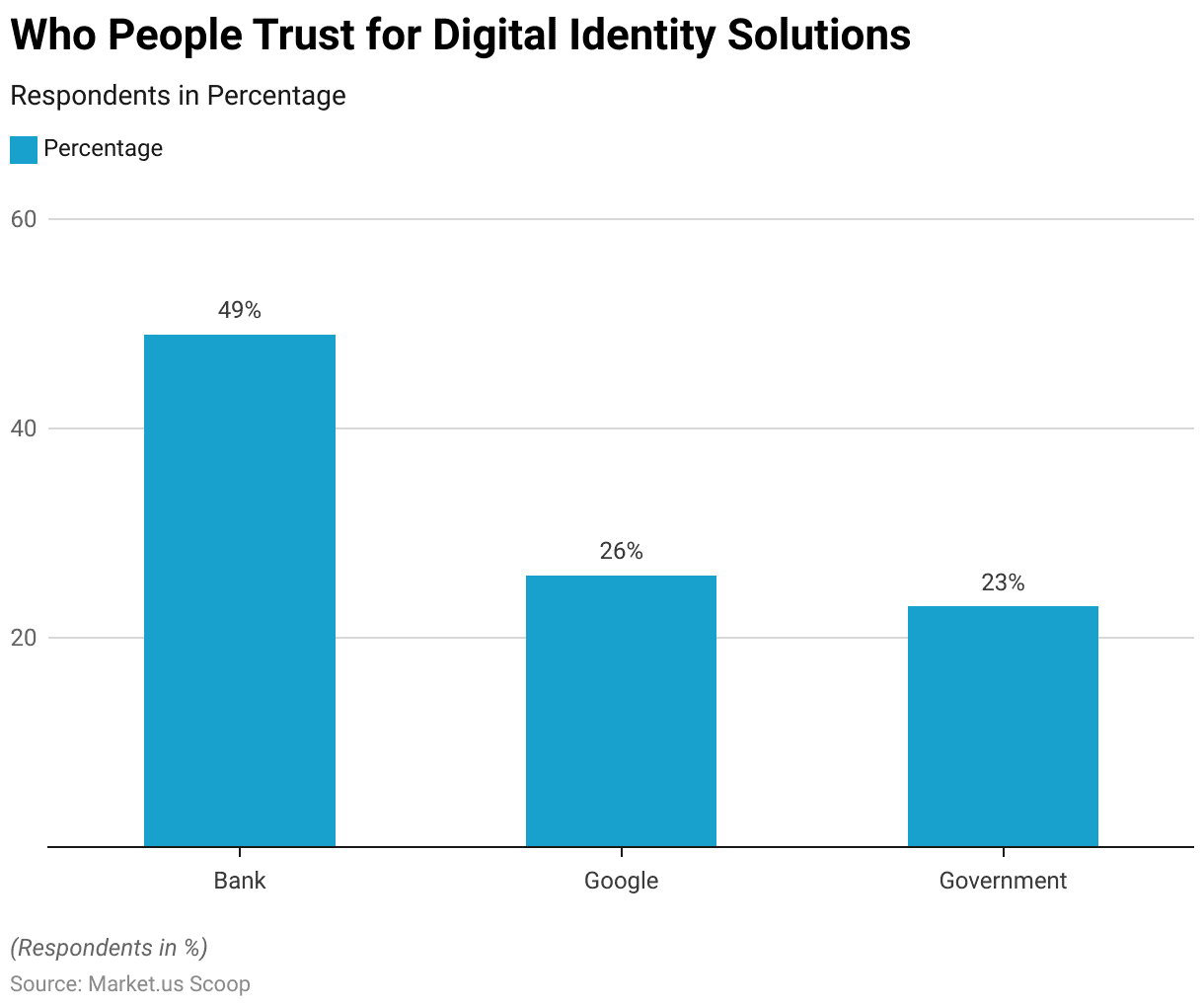
Issues Driving the Demand for Digital Identity Solutions
- The primary culprit behind significant insider data breaches is human error, according to 84% of organizations reporting security incidents stemming from mistakes.
- Concerns loom over the implications of remote and hybrid work arrangements for future breaches.
- A considerable 54% anticipate increased difficulty in thwarting data breaches caused by human error due to remote or hybrid work setups.
- Additionally, 50% foresee heightened challenges in preventing phishing attacks, while 49% express concerns about enforcing security protocols among remote employees.
Identity Verification for AML/KYC Purposes
- In 2021, organizations invested approximately $1.4 billion in AML and KYC data and services.
- A significant 92% of Americans have made online purchases, while over 75% have engaged in some form of online banking, prompting financial institutions to implement stricter identity verification measures.
- Moreover, 62% of highly connected consumers reported receiving payments through mobile wallets at least once within the preceding 12 months, according to the survey conducted.
Popular Digital Identity Schemes
United Nations
- The ID2020 summit held in New York in May 2016 saw the United Nations initiate discussions on digital identity, blockchain technology, and cryptographic advancements, emphasizing their potential benefits for marginalized communities.
- With the participation of 400 experts, the summit aimed to facilitate the exchange of best practices and ideas to ensure universal access to identity for all individuals.
- Subsequently, numerous countries began implementing or enhancing national electronic identification (eID) programs, encompassing traditional card-based systems and mobile-based initiatives, irrespective of the ID2020 initiative.
United Kingdom
- Notable programs such as the Gov.UK Verify initiative were launched in 2016, with the British government unveiling an updated version of its digital identity and attributes trust framework in August 2021.
Germany
- Germany announced plans in February 2021 for citizens to store a digital copy of their national ID card on mobile devices for use as a digital ID, authenticated via a personal identification number (PIN).
Canada
- Canada has also made progress with its federal digital identity initiative, the Pan-Canadian Trust Framework, led by the Digital ID Authentication Council of Canada (DIACC).
- A national proof-of-concept project for a unified login authentication service, sign in Canada, began in the fall of 2018.
India
- India’s national eID scheme, Aadhaar, exceeded one billion users in 2016, with over 1.3 billion Aadhaar electronic IDs issued as of August 2021, covering 99% of adults.
- The mAadhaar app, available in 13 languages on Android and iOS platforms since 2019, serves as a virtual ID card, leveraging biometric and demographic data.
Technological Advancements in Digital Identity Solutions
- The UN and World Bank’s ID4D initiative, in collaboration, aims to ensure that every individual worldwide possesses a legal identity by the year 2030.
- Additionally, momentum has been building for digital driver’s license projects, also referred to as mobile driver’s licenses, in various countries such as the UK, USA, Korea, Australia, Denmark, and the Netherlands.
- In April 2021, the US Department of Homeland Security Office of Strategy and Policy initiated a public request for comment regarding digital ID security standards and platforms.
- The objective is to facilitate Federal agencies, notably the TSA (Transit Security Administration), in accepting these credentials nationwide for official purposes.
Regulatory Standards for Digital Identity Solutions
- Australia took the lead in forming a new ICAO working group concentrating on digital travel credentials.
- The ICAO (Sub-Group) NTWG Logical Data Structure 2 initiated the preliminary stage of the LDS2 conception, to influence the future direction of ePassports.
- In Japan, interoperability tests were conducted in 2018, followed by similar tests in the USA and Australia in 2019, and then in the Netherlands and the USA again in 2021.
- The ISO/IEC 18013-5 standard was completed and released in September 2021. Originally intended to outline specifications for mobile driver licenses, this ISO standard extends its scope by clearly outlining security and communication protocols for digitalized documents, ensuring their verification and trustworthiness.
Challenges in Implementing Digital Identity Solutions
- Among banks, 62% cite “increased regulatory expectations and enforcement of current regulations” as the primary challenge in Anti-Money Laundering (AML) compliance.
- Additionally, 55% highlight the difficulty of having an adequate number of well-trained AML staff.
- Another significant challenge, identified by 48% of respondents, is the lack of sufficient or updated technology to manage AML compliance obligations.
- Regarding operational challenges in AML compliance, 80% mention the time-consuming nature of manual processes.
- Additionally, 74% express concerns about the poor quality of available data or the absence of a unified view of customer processes.
Discuss your needs with our analyst
Please share your requirements with more details so our analyst can check if they can solve your problem(s)



